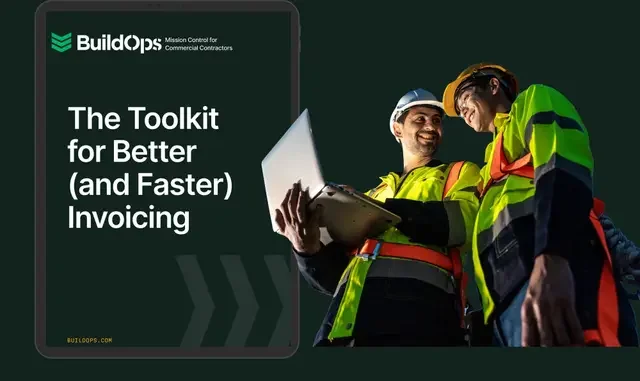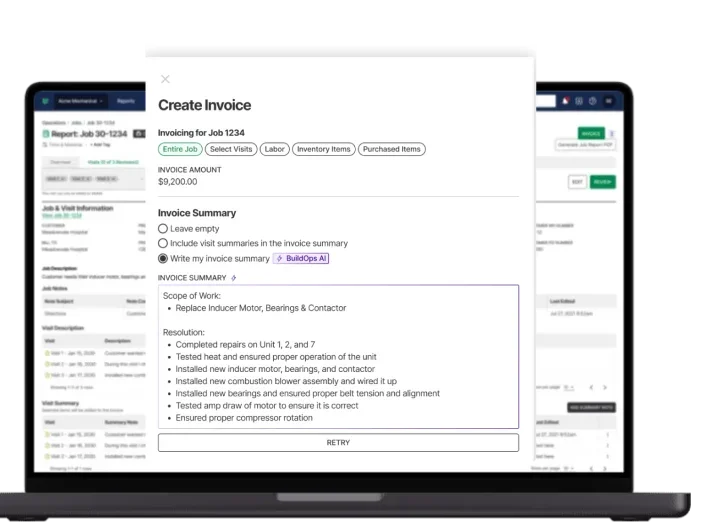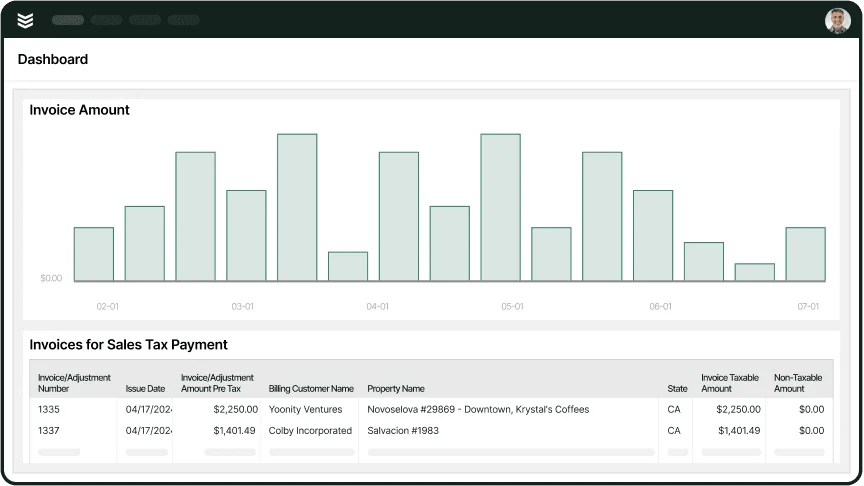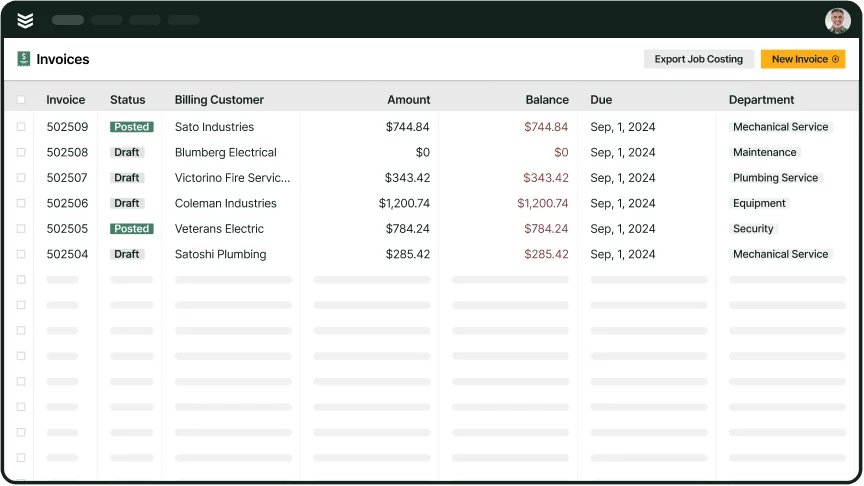Getting paid on time matters. It’s what keeps your business running. But when you’re juggling service calls, dispatch schedules, and crew coordination, billing often slips through the cracks. That’s where field service billing software comes in. With the right setup, invoicing and payment collection become fast, accurate, and automatic. No more chasing down late payments or sorting through handwritten job notes. Whether your team handles plumbing repairs, electrical installations, or fire safety checks, a billing tool that moves as fast as your crew can be a game-changer.
And if you're managing a field service team, contractor-ready billing software helps bring together labor hours, materials used, and service reports—all in one invoice that customers can easily review and pay. Here’s what this guide covers:
- How to choose the right field service billing software for your team
- 6 key features to look for in field service billing software
- Best for commercial contractors: BuildOps
- Best for residential contractors: Housecall Pro
- Best for general contractors: Jobber
- Other top field service billing software solutions for contractors
- 7 benefits of using field service billing software
- 4 answers to FAQs on field service billing tools
Whether you’ve got five techs or fifty, you need billing software that works like your crew does—quick, organized, and focused on getting the job done. We’ll break down what to look for, the tools that fit different types of contractors, and how to pick the one that keeps your cash flow moving.
How to choose the right field service billing software for your team
There’s no universal solution for field service billing. What works for an electrical contractor running 20 calls a day might not fit a plumbing company focused on long-term service agreements. That’s why picking the best software depends on what your crew actually needs in the field and back at the office.
Every business runs differently. But the end goal stays the same—create a process that cuts down on manual work, reduces billing errors, and gets you paid faster. Here are five things to think about when evaluating field service billing software:
- Payment types supported – Can your customers pay with credit cards, ACH, or mobile wallets? The more options you offer, the easier it is for them to pay quickly and on their terms
- Automation capabilities – Can the software auto-send invoices, track overdue payments, or handle recurring jobs without manual follow-up? Automation keeps things moving without constant check-ins
- Tool integration – Will it work with the systems you already use—like scheduling, dispatch, and accounting tools? If it doesn’t talk to the rest of your tech stack, it’ll just create more work
- Scalability – Whether you’re doing 15 jobs a week or 150, your billing system should grow with your team. Look for software that can handle more customers, invoices, and payment processing as your business expands
- Field-friendly features – Can techs invoice from the jobsite? Can they pull up service history, customer info, or capture signatures on the go? Features like these save time, eliminate paperwork, and help crews stay focused on the job
When you focus on what your team really needs—out in the field and inside the office—you’ll land on software that simplifies billing instead of slowing it down. Up next, we’ll dive into the core features worth paying attention to.
6 key features to look for in field service billing software
When billing slows down, everything else backs up—payments get delayed, technicians get frustrated, and office staff drown in follow-ups. That’s why good field service billing software connects every part of your operation, from the jobsite to the back office.
Let’s say your crew finishes a multi-day job on a tight deadline, and the tech in the field collects a signature on their phone. Instead of paperwork piling up until Friday, an invoice gets generated right then and there—payment collected, job closed, no calls back to the office. That’s the difference a connected billing platform makes in the field. Here are six essential features that power this kind of efficiency:
1. Technician mobile access
Techs shouldn’t have to drive back to the office just to fill out invoices or check payment history. A field service app for techs gives them ability to create, send, and track invoices right from their phone or tablet.
Let’s say a plumbing tech wraps up a drain line repair and captures the customer’s signature immediately. Instead of taking notes and handling paperwork later, the tech uses their mobile app to invoice on the spot. The customer gets a digital copy instantly, and the payment gets logged before the van even leaves the driveway.
2. Payment tracking and reporting
It’s one thing to send invoices. It’s another to know what’s actually been paid, what’s overdue, and which customers need a nudge. Reporting & analytics tools for field service make billing easy with real-time dashboards and insights.
Take, for example, a fire safety contractor managing dozens of inspection contracts across commercial sites. By the end of the month, the admin team can quickly pull reports showing which invoices were paid, which still need follow-ups, and where cash flow might be at risk—without sorting through spreadsheets or printed tickets.
3. Integrated scheduling and dispatch
Billing doesn’t start when the invoice is sent—it starts when the job gets scheduled. Scheduling and dispatch tools for field service billing ensure smoother handoffs from field to finance.
Say an HVAC technician is assigned a same-day emergency service call. The system logs the dispatch, auto-generates the job data, and when the work is completed, all the info flows directly into the billing module. No re-entry. No delay. That’s how jobs get billed same-day and payments come in faster.
4. Recurring service agreements
If your team handles regular maintenance jobs, recurring service agreements in field service software can automate invoices and payment reminders—keeping your revenue consistent without extra admin work.
Let’s say you’re running monthly fire alarm inspections across a portfolio of properties. Instead of manually building an invoice each month, the system automatically creates and sends it based on the service schedule—no skipped months, no missed payments, no chasing the client for approval.
5. Customer management tools
Tracking customer history, site-specific billing info, and communication logs matters when you're in the field. CRM tools for field service tie customer records to every invoice, job, and payment, making invoicing a breeze.
Picture this: your electrician finishes a job at a commercial site and pulls up the customer profile to confirm previous billing preferences. With everything from past invoices to service notes on hand, the tech knows exactly what to charge, how to bill it, and who to contact if there’s an issue—all from the same screen.
6. Time tracking integration
Accurate billing starts with accurate labor tracking. Time tracking tools for field service ensures labor hours are logged and billed correctly—without extra admin steps.
Think of a general contractor with crews clocking in and out of multiple job sites in a single day. Instead of guesstimating hours for billing later, time is tracked in real-time and synced directly to the invoice. Payroll stays clean, customers get billed correctly, and there’s zero back-and-forth on what was done when.
Other valuable billing features for field service teams
A strong billing system doesn’t stop at invoices and payments. The most effective field service billing software connects with other areas of your workflow—helping you manage jobs faster, keep costs under control, and make smarter decisions.
- Fleet management integration – Fleet management tools bring vehicle tracking into the billing process. When your technicians are covering large service areas, mileage and fuel costs can impact your bottom line fast. By tying GPS data and route history into your billing system, you can attribute costs to specific jobs, bill more accurately for travel time, and even identify inefficiencies like backtracking or excessive idle time. For teams with multiple vans or trucks in the field, this feature helps ensure every mile and minute counts.
- Quoting and estimating – Quoting features give your team the ability to build estimates, get approvals, and instantly convert those quotes into invoices. This closes the gap between sales and billing—reducing errors and speeding up cash flow. Whether it’s a quick HVAC system check or a larger plumbing install, having quoting built into your billing tools ensures you’re charging the right price based on the agreed scope. It also keeps customers informed and confident before the job even begins.
- Pipeline visibility – Sales pipeline tools allow you to track every job from the first inquiry to the final payment. Instead of guessing where a quote stands or manually checking in on unpaid invoices, your team gets a visual breakdown of active, pending, and closed opportunities. This helps service managers prioritize what needs attention—whether that’s a stalled quote, a missed follow-up, or a client that’s overdue. It’s a powerful way to tighten your billing process while staying on top of your entire service pipeline.

Looking to tighten up your billing process?
We break down key forms, templates, and processes every field team needs.
These tools round out your billing process, tying together the pieces that move jobs from field to invoice. Now let’s look at specific software options that fit best—starting with solutions designed for commercial contractors.
Best for commercial contractors: BuildOps
BuildOps billing software is a complete platform that connects invoicing and payments into one smooth workflow for commercial field service companies. It’s designed to handle complex, high-volume jobs across multiple teams and sites—ideal for contractors managing larger commercial accounts. From invoicing to payment collection, the system brings every step into one place and links directly with your existing scheduling and dispatch tools.
How Pricing Works: BuildOps offers weekly live demos and the option to request one-on-one walkthroughs to explore the features and find the best setup for your operation.
Features Beyond Invoicing:
- Automated billing workflows and payment tracking
- Real-time dashboards with financial insights
- Contract and customer history tools built for commercial service
What Sets it Apart for Commercial: BuildOps stands out by tackling the unique needs of commercial contractors—multi-location billing, advanced reporting, and seamless integration with your field tools. With everything connected, your billing system stays accurate, fast, and easy to manage.

Explore BuildOps Invoicing
Make it easy for field techs to bill clients on the spot so you get paid on time.
Best for residential contractors: Housecall Pro
Image Source: Housecall Pro
Housecall Pro is built for residential service pros who want a clean, no-fuss billing experience. With a mobile-friendly app and user-first interface, it’s easy for techs in the field to send invoices and collect payments—without needing to call into the office or sort through spreadsheets later. However, it may not be ideal for commercial or multi-division teams looking for more advanced reporting or integrations.
How Pricing Works: Housecall Pro offers a tiered pricing model that scales with the size of your team, starting with solo operators and growing with multi-tech setups.
Features Beyond Invoicing:
- Customer-friendly payment portals
- Integrated scheduling and follow-ups
- Mobile app with full invoice and service history access
What Sets it Apart for Residential: Housecall Pro keeps things simple and intuitive, especially for teams working directly with homeowners. From instant billing in the driveway to automated service reminders, it’s built for high-touch, high-efficiency work.
Best for general contractors: Jobber
Image Source: Jobber
Jobber helps general contractors stay on top of billing through every phase of a project—from first quote to final payment. It’s especially useful for contractors managing varied services or coordinating multiple jobs at once, thanks to its flexible invoicing, job tracking, and team coordination tools. That said, it may not be the best fit for large-scale operations that need advanced project billing or custom integrations.
How Pricing Works: Jobber offers custom plans depending on your team size and feature needs, with entry-level options available for smaller crews and advanced tools for growing companies.
Features Beyond Invoicing:
- Job tracking and multi-visit scheduling
- Customer communication and reminders
- Easy quote-to-invoice conversion
What Sets it Apart for General Contractors: Jobber balances simplicity with scale. Whether you're managing a single install or multiple service calls across different clients, its tools give you the clarity and control to keep billing accurate and on time.
Other top field service billing software solutions for contractors
Not every field service company needs the same set of tools. Some prioritize advanced features, others need quick setup and simplicity. If the main platforms don’t fit your workflow, here are five more billing software solutions worth exploring—each offering a unique advantage, with a few limitations to keep in mind.
FieldPulse
Image Source: FieldPulse
FieldPulse is a mobile-first platform built for small field service teams who want invoicing, estimates, scheduling, and light CRM tools all in one place. It helps teams stay organized in the field and improves visibility from the office. However, FieldPulse may not scale well for larger contractors needing complex integrations or high-volume processing.
How Pricing Works: FieldPulse uses a monthly subscription model with affordable entry points and paid feature add-ons.
Features Beyond Invoicing:
- Built-in job quoting and mobile estimates
- Digital payments and deposit tracking
- Centralized customer records
What Sets it Apart: Its balance of affordability and essential features makes it great for lean field crews getting off paper and into digital billing.
RazorSync
Image Source: RazorSync
RazorSync combines scheduling, billing, and field communication in one system, helping contractors close out jobs and get paid faster. Technicians can create invoices and accept payments from the jobsite, while office staff handle batch billing. However, RazorSync’s user interface hasn’t kept up with modern design standards, which can create a steeper learning curve for new users.
How Pricing Works: Pricing scales by number of users and access to premium features.
Features Beyond Invoicing:
- Customizable invoice and estimate templates
- Field-based payments and mobile invoicing
- Real-time team updates and job tracking
What Sets it Apart: It’s a practical option for smaller teams looking to automate without overspending, provided design and UI limitations aren’t a dealbreaker.
Fergus
Image Source: Fergus
Fergus is purpose-built for trades like electrical, HVAC, and plumbing, offering clear invoicing workflows, time tracking, and task costing. It’s designed to simplify job profitability tracking across the entire billing cycle. That said, it’s more widely used in markets like Australia and New Zealand, and may lack key integrations or region-specific features needed by U.S.-based businesses.
How Pricing Works: Fergus offers flat-rate monthly pricing with plans based on user count and access level.
Features Beyond Invoicing:
- Invoice reminders and overdue tracking
- Job and project budgeting
- Calendar scheduling for field crews
What Sets it Apart: Great for trades-focused shops needing cost visibility—but best for teams comfortable working with international platforms.
WorkWave Service
Image Source: WorkWave
WorkWave Service is ideal for recurring service contractors like pest control, cleaning, or lawn care. Its billing features are built around repeat visits, with automatic invoice creation and customer communications integrated into each job cycle. However, it may not meet the needs of general contractors or teams who don’t work on subscription-based service models.
How Pricing Works: Custom pricing based on team size, industry, and selected modules.
Features Beyond Invoicing:
- Recurring scheduling with linked invoices
- Client communication and reminders
- Mobile access for techs and admins
What Sets it Apart: For high-frequency service routes, it shines. But teams working one-off projects or custom installations may find it too narrow in focus.
Simpro
Image Source: Simpro
Simpro is a comprehensive system built for commercial and project-based contractors needing complex billing, job costing, and inventory tracking. It’s best for teams managing large jobs across phases and multiple technicians. That said, Simpro’s implementation process can be lengthy and may require in-house admin support to maintain over time.
How Pricing Works: Simpro offers customized plans tailored to your business size, industry, and required features.
Features Beyond Invoicing:
- Project-based and progress invoicing
- Inventory and materials management
- Detailed job costing reports
What Sets it Apart: Simpro is a strong choice for contractors ready to commit to a long-term platform with deep functionality—but it may be more than what smaller or simpler operations need.

Speed up payment times with BuildOps
Find out how you can streamline invoicing and eliminate late payments.
7 benefits of using field service billing software
Billing software helps field service teams cut down on chaos. From job completion to getting paid, every step gets cleaner, faster, and easier to track. Whether you're in the truck or at a desk, having a billing system connected to how your team actually works makes a huge difference day to day.
1. Faster turnaround from job to invoice
The longer it takes to send an invoice after a job, the slower the payment. Billing tools that work with dispatch details let teams create and send invoices right after the work wraps up—no extra paperwork or waiting. For teams managing fast-paced schedules, using dispatch and invoicing software ensures jobs and billing stay connected without delay.
Expert Tip
There’s also a timing sweet spot that helps maximize how quickly you get paid—too soon and customers may not be ready, too late and it slips through the cracks. The Invoicing Sweet Spot explains how service teams can find the best window for sending invoices and why hitting it improves payment turnaround.
2. Less time spent chasing payments
Late payments slow cash flow and eat up admin time. Automated reminders, payment tracking, and easy-to-read digital invoices help keep collections consistent. Tools that support invoice automation software features reduce follow-ups and make it easier for clients to settle up on time.
3. Real-time visibility across jobs and payments
Having a full view of what’s been billed, what’s outstanding, and what’s been paid helps everyone stay on the same page. Techs, admins, and managers can make faster decisions when billing data is synced across the entire workflow, leading to improved communication and efficiency.
4. Fewer billing errors from manual entry
Missed charges, math mistakes, and double entries all cost money. Billing systems that pull data straight from job logs, time tracking, or material usage reduce errors and make sure every billable item shows up on the invoice. This automation eliminates the need for manual data entry, which is prone to human error. Additionally, data integration ensures that the information on the invoice is consistent with the information in other systems, such as job logs and time tracking software.
5. Smoother coordination between scheduling and invoicing
When the billing system links to the scheduling tool, your team doesn’t have to second-guess what work was done or when to invoice. Job details flow from one step to the next without extra admin work. Using scheduling and invoicing software is especially useful for high-volume contractors where timing and accuracy matter.
6. Better support for lean or mobile teams
Smaller crews wearing multiple hats don’t always have time for manual invoicing or tracking payments in spreadsheets. Tools designed for fieldwork and fast invoicing make things easier, even without a full office staff. This is where invoicing software for small businesses makes a big impact, keeping things organized without adding extra overhead.
7. Improved customer experience
Billing isn’t just about getting paid—it’s part of how customers judge your service. Clear invoices, fast delivery, and flexible payment options make a big impression. A smoother billing process leads to fewer questions, quicker approvals, and repeat business. This positive experience builds trust and loyalty, encouraging customers to choose your business for future projects and recommend you to others.
4 answers to FAQs on field service billing tools
When you're choosing software to handle invoicing and payments, it's normal to have questions—especially if your team works across job sites, not desks. From understanding how these tools actually work to knowing how to make the most of them, here are the answers service teams ask most.
1. What is field service billing software?
Field service billing software is designed to help contractors generate and manage invoices and payment processing based on completed work in the field. It connects your scheduling, job tracking, and other processes into one system, reducing errors and making it easier to get paid on time.
These tools are built with mobile teams in mind, helping techs create invoices on-site, track what’s been billed, and sync directly with the back office—so no work slips through the cracks. This gives your business a centralized hub for all billing-related information, accessible from both the field and the office.
2. How does billing software support mobile field teams?
For mobile techs, billing software eliminates the need to return to the office or rely on paper invoices. It gives technicians access to digital tools that let them generate, send, and even collect payments on the jobsite. Everything syncs in real time, making it easier for admins to track job status, reduce billing delays, and keep customer records up to date. It also helps field teams stay on top of completed tasks without creating extra admin work.
3. Can field service billing software work with other tools I already use?
Yes. Most modern billing platforms are designed to integrate with key tools you’re likely already using—such as scheduling apps, dispatch boards, CRM systems, accounting platforms, or time tracking software. These integrations help you avoid entering the same info twice, reduce the chance of billing mistakes, and keep your operations fully aligned. When evaluating software, check whether it connects with tools like QuickBooks, Google Calendar, or whatever you use for job management.
4. What are the best practices for using field service billing software?
Rolling out billing software is only part of the process. To actually see results—faster payments, fewer errors, and better team coordination—you’ll want to build habits around how it’s used. Here’s what strong teams consistently do:
- Keep job details accurate and updated in the system
- Train techs to create invoices directly from the jobsite
- Sync time tracking with your invoicing workflows
- Use invoice templates to stay consistent across all jobs
- Automate recurring invoices for repeat clients or contracts
- Set up alerts for unpaid invoices or overdue payments
- Regularly audit your invoice history to spot trends or issues
- Integrate billing with your CRM and scheduling tools for a complete workflow
- Review billing reports monthly to adjust pricing or scope where needed
Following these best practices keeps your invoicing process tight, saves hours in admin work, and helps your crew stay focused on the jobs that actually generate revenue by eliminating the need to chase down payments or manually enter data.
Managing invoicing and payments shouldn’t slow your crew down. Whether you're running residential calls, juggling service agreements, or coordinating large commercial installs, field service billing software helps tighten your process, cut the admin clutter, and keep your cash flow predictable.
The best tool is one that fits how your team actually works—connecting what happens in the field to what happens in the office. From mobile invoicing to real-time reporting and integration with scheduling tools, having your billing system aligned with your day-to-day operations makes a big difference. If you're running a commercial service team and need an all-in-one platform that handles complex billing, multi-location clients, scheduling, and dispatch all under one roof, BuildOps can check those boxes.

Curious how it could work for you?
Automate processes to save time, streamline billing, and get paid quicker.







